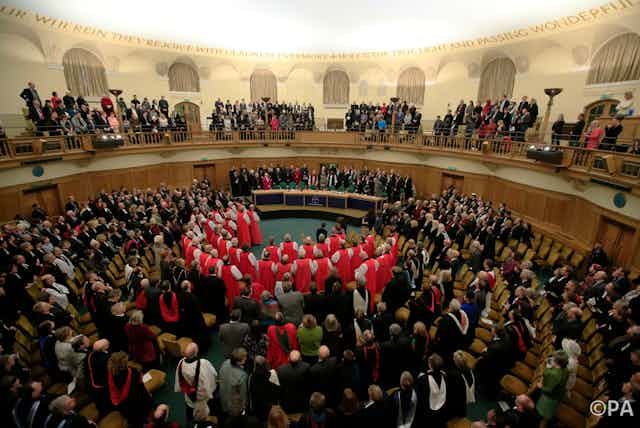As the newly elected synod of the Church of England meets for the first time during its term of five years, questions are being raised about the survival of the church as we have known it.
The new synod, whose members were elected in October, convenes at a crucial juncture with the future of the established church at stake. Church membership has been hit by a steep decline and elderly people now form the core of its congregations. It’s expected that 40% of the clergy will retire over the next decade – and there are few matching new recruits arriving to fill their shoes.
All this as the socio-cultural and ethnic make-up of British society has undergone tremendous change. Same-sex marriage is legal in Britain, except of course for the Church of England. The church recently learned a harsh lesson about British society – when it could not even screen an advertisement in cinemas without concern that it would cause offence.
The members of the newly elected synod – still dominated by white, middle-class men – are expected to mull over these harsh realities along with addressing some of the pressing issues set by their predecessors.
The previous synod came under severe criticism from a wide range of people for its lack of consultative approach and its habit of fast-tracking many important decisions, such as MBA-style leadership training for potential bishops and other leaders in the church, while silently ignoring the debate on same-sex marriage.
The first hurdle for this synod will be getting over the fact that many new members have been elected on a mandate to revisit the changes implemented in the previous synod.

Reform and renewal
One of the main agenda items this time is to address the proposed “Reform and Renewal” programme spearheaded by the archbishop of Canterbury, Justin Welby.
Although the programme has been given a spiritual makeover, the changes it proposes are simply managerial – geared towards efficiency and performance, arresting decline and increasing its membership base to keep it in business.
The business model of reform and the economics of renewal are underpinned by one objective: the numerical growth of the church. Many of the mission plans across the church are drawn in such a way as to address the underlying problem of ageing church membership and declining new arrivals.
Instead of making sense of the demographic change of the society, the church leadership has identified issues with leadership as the core area for development. The ambiguous 2014 report by Stephen Green laid the platform to develop chief executive-style leaders who are equipped to turn an ailing business into a growth-oriented business – in this case a successful church with growing congregations.
What is worrying for many is the manner in which the changes are being implemented. Hot on the heels of chief executive training on the agenda is disinvestment, or strategic reallocation of funding to different parts of the church.
It is inevitable that many churches will be closed for good under the new divestment agenda, as they will struggle to pay their parish share due to declining numbers, leaving communities to search for alternatives.
Also on the table are more appealing, flexible theological training options to attract more young people. These changes are underscored by a distaste for both tradition and liberal values.
The reform and renewal agenda focuses extensively on the clergy and fails to give equal importance to lay ministry. It will be for this synod to decide whether to go with a steady business approach to restore the establishment, or follow the early church in being a movement of the people.
Questions of human sexuality and ethnicity
The Church of England leadership is determined that the agenda of reform and renewal should continue to tread a conservative evangelical path, excluding those who choose to publicly acknowledge their commitment to one another in same-sex marriage.
Yet some new appointees to the synod, such as Britain’s first openly gay vicar, are determined to make the church accountable and address its discriminatory practices.
At the same time, more Christians are now coming from other ethnic minority communities, reflecting the overall change in British society. Nevertheless, there is a blatant lack of representation from ethnic minority Anglicans in the synod and in the wider church leadership. Stephen Cottrell, the bishop of Chelmsford, has confessed that the church has failed to be inclusive and tacitly continues its racist practices.
Medieval or not
Among some of the proposed changes to the structure of the Church of England that will go through without much debate at the synod are the proposal to repeal obsolete medieval laws and to scrap old marriage regulations that require banns to be read in church before a wedding.
Yet lack of consultation and debate in other areas are worrying some within the church. Change for survival at the expense of a church that is grounded in its communities is disquieting.
The recent terrorist attacks in Paris have reiterated the important role that faith communities have to play for a safer and better society by working together. The “mission” priority of being a numerically successful church does not sit well with the pluralism of multi-faith modern Britain. Somehow the reform and renewal agenda does not resonate with those necessities of our times.
The challenge for the present synod is to restore the Church of England’s lost touch with society, to think hard how to regain its prophetic voice in the community and not spend so much of its valuable time on plans of self-preservation.

